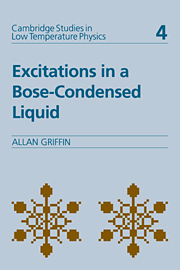Book contents
- Frontmatter
- Contents
- Preface
- 1 Theory of excitations in superfluid 4He: an introduction
- 2 Dynamic response of Helium atoms to thermal neutrons
- 3 Bose broken symmetry and its implications
- 4 High-momentum scattering and the condensate fraction
- 5 Dielectric formalism for a Bose fluid
- 6 Response functions in the low-frequency, long-wavelength limit
- 7 Phonons, maxons and rotons
- 8 Sum-rule analysis of the different contributions to S(Q, ω)
- 9 Variational and parameterized approaches
- 10 Two-particle spectrum in Bose-condensed fluids
- 11 Relation between excitations in liquid and solid 4He
- 12 The new picture: some unsolved problems
- References
- Author index
- Subject index
6 - Response functions in the low-frequency, long-wavelength limit
Published online by Cambridge University Press: 23 September 2009
- Frontmatter
- Contents
- Preface
- 1 Theory of excitations in superfluid 4He: an introduction
- 2 Dynamic response of Helium atoms to thermal neutrons
- 3 Bose broken symmetry and its implications
- 4 High-momentum scattering and the condensate fraction
- 5 Dielectric formalism for a Bose fluid
- 6 Response functions in the low-frequency, long-wavelength limit
- 7 Phonons, maxons and rotons
- 8 Sum-rule analysis of the different contributions to S(Q, ω)
- 9 Variational and parameterized approaches
- 10 Two-particle spectrum in Bose-condensed fluids
- 11 Relation between excitations in liquid and solid 4He
- 12 The new picture: some unsolved problems
- References
- Author index
- Subject index
Summary
In this chapter, we use the formalism developed in Sections 3.2, 5.1 and 5.4 to discuss various correlation functions in the long-wavelength, low-frequency limit. It is important that the microscopic theory based on a Bose broken symmetry used to describe the high-frequency excitations probed by neutrons also explains the low-frequency behaviour which characterizes superfluidity. In Section 6.1, we show how the generalized Ward identities given in Section 5.1 lead in a simple way to several rigorous zero-frequency sum rules. We discuss the structure of the low-frequency, long-wavelength response functions and make contact with the two-fluid description of Landau. In Section 6.2, we discuss the structure of the correlation functions in the hydrodynamic region, as given by the two-fluid equations of Landau (see Khalatnikov, 1965). While the hydrodynamic region of S(Q, ω) is difficult to probe by thermal neutron scattering, it can be studied by inelastic Brillouin light scattering (for excellent reviews, see Stephen, 1976; Greytak, 1978).
In Section 6.3, starting from the Gavoret–Nozières formalism summarized in Section 5.4, we review GN's explicit calculation of the phonon spectrum of Gαβ and χnn (at T=0). We comment on the significance of the infrared divergences in the Q, ω → 0 limit first noted by Gavoret and Nozières (1964) and clarified in later work, by Nepomnyashchii and Nepomnyashchii (1978), Popov and Serendniakov (1979), and Nepomnyashchii (1983). We also discuss the relation between first and second sound which occurs in the hydrodynamic region and the phonons which arise in the collisionless region.
- Type
- Chapter
- Information
- Excitations in a Bose-condensed Liquid , pp. 127 - 152Publisher: Cambridge University PressPrint publication year: 1993

